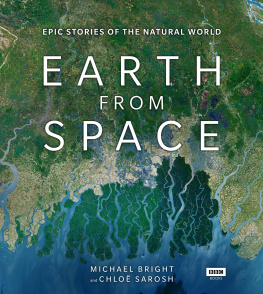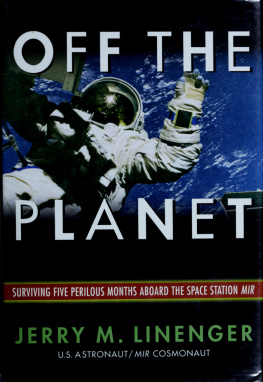
Copyright 2021 by Nicole Stott
Cover design by Ann Kirchner
Cover images: NASA; Buradaki/Shutterstock.com
Cover copyright 2021 by Hachette Book Group, Inc.
Frontispiece copyright NASA
Hachette Book Group supports the right to free expression and the value of copyright. The purpose of copyright is to encourage writers and artists to produce the creative works that enrich our culture.
The scanning, uploading, and distribution of this book without permission is a theft of the authors intellectual property. If you would like permission to use material from the book (other than for review purposes), please contact permissions@hbgusa.com. Thank you for your support of the authors rights.
Seal Press
Hachette Book Group
1290 Avenue of the Americas, New York, NY 10104
www.sealpress.com
@sealpress
First Edition: October 2021
Published by Seal Press, an imprint of Perseus Books, LLC, a subsidiary of Hachette Book Group, Inc. The Seal Press name and logo is a trademark of the Hachette Book Group.
The Hachette Speakers Bureau provides a wide range of authors for speaking events. To find out more, go to www.hachettespeakersbureau.com or call (866) 376-6591.
The publisher is not responsible for websites (or their content) that are not owned by the publisher.
Library of Congress Cataloging-in-Publication Data
Names: Stott, Nicole (Astronaut), author.
Title: Back to Earth : what life in space taught me about our home planetand our mission to protect it / Nicole Stott.
Description: First edition. | New York : Seal Press, 2021. | Includes bibliographical references and index.
Identifiers: LCCN 2021009682 | ISBN 9781541675049 (hardcover) | ISBN 9781541675032 (ebook)
Subjects: LCSH: Stott, Nicole (Astronaut) | International Space StationBiography. | NatureEffect of human beings on. | Human ecology | Environmentalism. | Women astronautsUnited StatesBiography.
Classification: LCC GF75 .S79 2021 | DDC 304.2dc23
LC record available at https://lccn.loc.gov/2021009682
ISBNs: 97815416 75049 (hardcover), 97815416 75032 (ebook)
E3-20210906-JV-NF-ORI
To my son Roman.
You are my greatest blessing (and my favorite Earthling).
I cant wait to see the good you do in the world. You are the reason I wrote this book.
Explore book giveaways, sneak peeks, deals, and more.
Tap here to learn more.

For we Earthlings, we human beings, are the only life form that we know of that can dream, then plan and work together to achieve that dream. We are extraordinary in the universe in that our only limits are those we place on ourselves.
Alan Bean (19322018), artist and Apollo Moonwalker

NASA
Astronaut Bill Anders became the first person to photograph our planet rising above the Moon. He took this iconic image, Earthrise, in 1968 during Apollo 8, the first crewed mission to orbit the Moon.
B ILL ANDERS AND HIS TWO APOLLO 8 CREWMATES , Jim Lovell and Frank Borman, were the first human beings to leave the relative safety of low Earth orbit and travel a quarter of a million miles out into space to circle the Moon. They were also the first to witness, in person, the beautiful spectacle of our colorful planet, full of life and set against the stark and seemingly endless black backdrop of space, rising in stunning contrast above the lifeless surface of the Moon.
Anders snapped a photo and became the first human to capture a photograph of this event, an iconic image now famously and appropriately known as Earthrise. Lucky for us, the astronauts did not keep this vision to themselves. Instead, on Christmas Eve of 1968, while still in lunar orbit, they shared it with all of us back here on Earth. This single image forever shifted humanitys perspective on who we are and our place in the universea simple yet powerful reminder of the undeniable reality of our ultimate interconnectivity and interdependence.
We are all Earthlings.
In 2019, we celebrated the fiftieth anniversary of the Apollo space missions that took human beings off our planet and to the Moon. I believe its no coincidence that 2019 also marked the forty-ninth anniversary of both the first Earth Day and the formation of the US Environmental Protection Agency (EPA). Earthrise, the beautiful image of our home planet with its naturally perfect life support system, protected by a thin blue line of atmosphere, has been a symbol of the environmental movement ever since the Apollo 8 crew first shared it. But do we still appreciate its significance?
In 2009, forty years after I watched with my family on our black-and-white TV as the Apollo 11 astronauts walked on the Moon, I flew to space for the first time and experienced my own Earthrise moment.
As astronauts, we do our best to prepare for both the planned activities of our mission and the unexpected events that might happen along the way. Included in that preparation is communicating with our astronaut colleagues to learn as much as we can from their spaceflight experiencesincluding what it was like for them to see Earth from space. For some reason, I thought I could prepare for that special space-bound experience by looking at pictures and videos. Wrong.
Let me just say that the perspective offered through the windows of the spacecraft was so overwhelmingly impressive and beautiful that it far exceeded my highest expectations. No picture, no video, and no conversation with others who had flown before could have prepared me for what I saw with my own eyes and felt with my own soul.
The view was crystal clear and glowing. The simplest way I can explain it to you is the same way I explained it to my seven-year-old son the first time I called him from space. I told him to imagine he had the brightest light bulb ever, splattered with all of the colors we know Earth to be, and that when he turned it on, it was almost too bright to look at. All the Earths colors glowed with an iridescence and translucence Id never seen before.
My Earthrise moment came while looking out the windows of the Space Shuttle and the International Space Station (ISS). Absorbed in that view of a translucent Earth, I realized something Id actually known all along, something Id probably learned in kindergarten, in 1968, the same year as the Apollo 8 missionwe live on a planet!
I found it strange that this simple truth could be so revelatory. But then again, how often do any of us contemplate its profundity? While its cool that nearly everyone can see Earthrise every day, the downside is that we seem to have become desensitized to its significance. Since Bill Anders took that first photograph, Earthrise, images of the Earth from space have become ubiquitous. Through the wonders of technology, we see these images in lots of places every dayin advertisements, on flight tracker screens during airline travel, and through apps like Google Earth on our smartphones.









